Antibacterial Assay and Alkaloid Lombine Distribution Study of Voacanga foetida (B.I) Rolfe from Lombok Island
Surya Hadi*1, Baiq Desy Ratnasari1, Maulida Septiyana1, Seto Priyambodo2 and I. Made Sudarma1
1Department of Chemistry, University of Mataram, Mataram, 83121, Indonesia.
2Department of Medical Education, University of Mataram, Mataram, 83121, Indonesia.
Corresponding Author E-mail: sur_hadi88@yahoo.com
DOI : http://dx.doi.org/10.13005/ojc/350133
Article Received on : 30-11-2018
Article Accepted on : 12-01-2019
Article Published : 31 Jan 2019
Overall aims of this research was to study the antibacterial activity of Voacanga foetida and then studied the distribution of the alkaloidal lombine produced in the plant, in which the samples were collected from three different regions. The antibacterial activities were assayed using agar well diffusion method. The distribution of the alkaloids in Voacanga foetida, especially lombine was studied on the basis of GC-MS in several temperature programs. The result showed that the leaves and the barks of Voacanga foetida were possessing antibacterial properties. The second result, GC-MS showed that alkaloidal lombine was produced stably in the barks while not in the leaves. The abundance of lombine in the base fraction of the barks was 6.06% (West Lombok), 74.91% (East Lombok), and 2.77% (North Lombok). The outcome will be then used as a platform for further studies investigating total uses of the plant especially in finding new materials for medicine.
KEYWORDS:Antibacterial Activity; Alkaloids; GC-MS; Lombine; Voacanga Foetida
Download this article as:| Copy the following to cite this article: Hadi S, Ratnasari B. D, Septiyana M, Priyambodo S, Sudarma I. M. Antibacterial Assay and Alkaloid Lombine Distribution Study of Voacanga foetida (B.I) Rolfe from Lombok Island. Orient J Chem 2019;35(1). |
| Copy the following to cite this URL: Hadi S, Ratnasari B. D, Septiyana M, Priyambodo S, Sudarma I. M. Antibacterial Assay and Alkaloid Lombine Distribution Study of Voacanga foetida (B.I) Rolfe from Lombok Island. Orient J Chem 2019;35(1). Available from: https://bit.ly/2CUEdDy |
Introduction
Voacanga foetida (BI)Rolfe, locally known as kumbi, is a part of the Apocynaceae family that distributed mainly in Indonesia, especially in Lombok Island (Perry et al., 1980). The plant has a small tree that vegetate individually in the forest. The leaves are green, big, triangular shaped. The fruits are round with green color that will change into reddish when it is mature. Since the plants are not edible, the villagers utilizing the leaves and the barks to treat the wound and skin infections (Riswan and Dwi, 2008). These therapeutic uses are likely indicating its antibacterial properties. Hadi et al, (2002) stated that the alkaloid extracts from the V. foetida was effectively inhibiting bacteria. A follow-up study by Novianti (2014) also found the same result about the alkaloid extract activity. However, the methanol extract unexpectedly showed no antibacterial activity. Therefore, to ensure the antibacterial activity from V. foetida, this research covered a further antibacterial assay of V. foetida extracts using more bacteria.
The alkaloid is one of the secondary metabolites that possess an antibacterial property. There are many notable alkaloid compounds had been isolated from the Apocynaceae family. However, the alkaloid on V. foetida species has not explored thoroughly. There were only four alkaloids had been identified from V. foetida species, in which, three of them were common alkaloids that found also in the other species of Apocynaceae family, namely voacangine, voacristin, and coronaridine (Hadi et al., 2002). One of the isolated compounds was lombine, a newly identification alkaloid. In order to build up the alkaloid collection in V. foetida species, this study was designed to identify the alkaloid from three different cultivated areas on the basis of GC-MS analysis.
Lombine, the newly isolated alkaloid was isolated from the barks parts of V. foetida by Hadi et al (2002) and found to effectively inhibit E. coli and S. aureus from the concentration of 0.5 mg/ml. Therefore, lombine is a potent material for a new lead compound of new antibiotic development. Nevertheless, the existence of lombine in the barks was unstable. Hadi et al (2002) found lombine as a major compound in the barks of V. foetida from Kekait village, West Lombok. However, a follow-up identification from different cultivated location showed no presence of lombine. Hence, this research intends to explore the distribution of the lombine by identifying the presence of lombine in the leaves and the barks of V. foetida collected from three different areas of Lombok Island.
Materials and Methods
Materials
The main material of this research was the leaves and the barks of V. foetida (BI) Rolfe that collected from three different locations of Lombok Island, Indonesia, namely North Lombok (Pusuk Forest), West Lombok (Suranadi Forest), and East Lombok (Tetebatu Forest). For the antibacterial assay, the samples extracts activity was tested against five different bacteria which were Staphylococcus aureus, Escherichia coli, Shigella dysenteriae, Streptococcus mutants, and Staphylococcus epidermidis that obtained from the collection of Biology Laboratory, Faculty of Mathematics and Natural Sciences, the University of Mataram.
Research Place
The research was conducted in the laboratories under the Faculty of Mathematics and Natural Sciences, University of Mataram, namely Analysis Laboratory and Biology Laboratory.
Instrumentation
The presence of alkaloid including lombine in the samples was identified using Gas Chromatography-Mass Spectrum (GC-MS), Shimadzu QP2010 ULTRA, the RTX-5MS capillary column with a length of 30 m, diameter 0.25 mm and film thickness 0.25µm. Helium was used as the gas carrier with flow rate 30ml/min. The molecular mass range of ions was identified at 35-500 m/z. There were four temperature programs used as GC parameters in order to find the optimum condition for GCMS analysis of alkaloid.
Setting 1
The injection temperature was set to 260°C with initial column started at 40°C for 5 minutes and programmed to increase 30°Cper minute until it reached 260°C for 7 minutes.
Setting 2
The injection temperature was set to 200°C with initial column started at 100°C for 5 minutes and programmed to increase 12°C per minute until it reached 280°C for 5 minutes.
Setting 3
The injection temperature was set to 260°C with initial column started at 150°C for 5 minutes and programmed to increase 18°C per minute until it reached 270°C for 5 minutes.
Setting 4
The injection temperature was set to 200°C with initial column started at 100°C for 5 minutes and programmed to increase 9°C per minute until it reached 290°C for 5 minutes.
Procedure
As mentioned previously, there were two aims of the research, firstly, analyzing the antibacterial activity of the V. foetida extracts, secondly, studying the alkaloid presence in V. foetida, especially alkaloidal lombine, on the basis of GC-MS. The samples (the barks and the leaves) were collected from the North Lombok (Pusuk Forest), the West Lombok (Suranadi Forest), and the East Lombok (Tetebatu Forest).
Preparation
The samples (parts of leaves and bark, 3 kg each) were dried at room temperature (27°C), then grounded into fine powder. The finely powdered samples were extracted using methanol for 3×36 h. Furthermore, the crude methanol extracts were fractionated using acid-base extraction (Hadi et al., 2002). Firstly, the extracts were acidified to pH 3-4 using acetic acid (5%), then partitioned to organic phase (acid) and water phase (alkaloid) using dichloromethane (DCM). The alkaloid in the water phase was extracted by basifying the extract to pH 10, then re-partitioned using DCM to get the alkaloid extract. The fraction was then prepared according to the aim of the study follows.
Antibacterial Assay
The antibacterial activity of the V. foetida extracts were in-vitro tested by agar well diffusion method (Balouiri et al., 2016). Agar plates were inoculated with the bacterial strains (S. aureus, E. coli, S. dysenteriae, S. mutants, and S. epidermidis), incubated for 24 h at 37°C. The wells with diameter 6mm-8mm then created in the agar plate. The plant extracts (the crude methanol extract, the acid fraction, and the base fraction) were diluted into 1000 ppm, 100 ppm, and 10 ppm before added to the wells. Methanol p.a and DCM p.a were used as the negative controls while ciprofloxacin 0.5% was used as the positive control. The agar plates then incubated for 24 h at 37°C. The inhibition zone of each fraction against each bacterium was recorded. The experiment was done in triplicate and standard deviation of the data was calculated.
Alkaloid Analysis and Alkaloidal Lombine Distribution Study
The crude methanol extract of the samples was semi-quantitatively tested using Mayer and Wagner reagent (Raaman et al., 2006). On the other side, the base fraction from acid-base extraction was analyzed on the basis of GC-MS in four different temperatures programs of GC parameters as it wrote in the instrumentation section. The alkaloid compounds, especially alkaloidal lombine presence in the sample then identified based on their ion mass fragmentations. Lombine gave unique spectrum at 130 m/z and 144 that indicating unsubstituted indoles moiety, 337 m/z and 293 m/z for carbomethoxy group, 172 m/z and 208 m/z for lombine skeleton, and 352 m/z for lombine molecular weight. More details explanation is placed in Figure 5 of the result and discussion section.
Result and Discussion
Antibacterial Assay
In order to study the potency of antibacterial activities of V. foetida, three different extract/fractions of the V. foetida were tested in three concentrations (1000, 100, and 10 ppm). Ciprofloxacin was used as Positive control, while methanol (MeOH) and the dichloromethane (DCM) solvents were applied as negative controls. The two controls were found to be ineffective against the bacteria, thus, it concluded that the inhibition results purely came from the tested materials. The further detailed results are explained below.
The Antibacterial Activity of the Bark
The antibacterial activity of the extracts was assayed by measuring the diameter of inhibition zone that formed around of the wells (mm). The bigger the diameter of the wells was, the strongest antibacterial activity showed.
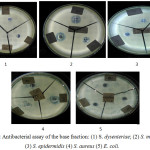 |
Figure 1: Antibacterial assay of the base fraction: (1) S. dysenteriae; (2) S. mutans (3) S. epidermidis (4) S. aureus (5) E. coli. |
There were three extracts that tested against five different bacteria, namely methanol extract, acid fraction, and base (alkaloid) fraction. However, this paper only displayed the base fraction result as a figure. Therefore, the diameter zone (mm) from all of the extracts were presented in the form of Table 1 instead.
Table 1: The inhibition zone of the barks extracts.
|
Tested Materials |
Concentration (ppm) |
Inhibition Zone (mm) |
||||
| (1)* |
(2)* |
(3)* |
(4)* |
(5)* |
||
|
Methanol extract |
1000 |
18.3±0.6 |
18.0±0.0 |
15.3±0.5 |
18.7±0.6 |
14.0±1.0 |
|
100 |
14.7±0.6 |
15.0±1.0 |
13.3±0.5 |
16.7±0.6 |
12.0±0.0 |
|
|
10 |
13.0±0.0 |
12,4±0.5 |
11.3±0.5 |
14.3±0.5 |
10.0±1.0 |
|
|
Acid Fraction |
1000 |
12.4±0.6 |
12.7±0.6 |
11.7±0.5 |
26.0±1.0 |
0.0±0.0 |
|
100 |
11.0±1.0 |
11.7±0.5 |
10.3±0.6 |
12.7±0.5 |
0.0±0.0 |
|
|
10 |
10.0±0.0 |
10.7±0.6 |
8.3±0.5 |
10.3±0.5 |
0.0±0.0 |
|
|
Base Fraction |
1000 |
16.7±0.6 |
14.0±0.0 |
15.0±0.0 |
18.0±0.0 |
16.3±0.6 |
|
100 |
12.7±0.5 |
11.4±0.5 |
10.7±0.5 |
15.0±0.0 |
12.7±0.5 |
|
|
10 |
10.0±0.0 |
10.0±0.0 |
8.3±0.5 |
10.7±0.6 |
10.7±0.6 |
|
|
Ciprofloxacin |
0.5% |
50.0±1.0 |
50.0±1.0 |
35.0±1.0 |
35.0±1.0 |
35.0±1.0 |
|
Methanol |
PA grade ** |
0.0±0.0 |
0.0±0.0 |
0.0±0.0 |
0.0±0.0 |
0.0±0.0 |
|
DCM |
PA grade ** |
0.0±0.0 |
0.0±0.0 |
0.0±0.0 |
0.0±0.0 |
0.0±0.0 |
*(1) S. aereus, (2) E. coli, (3) S. dysenteriae, (4) S. mutans, (5) S. epidermidis ** Pro Analysis grade
Generally, Table 1 shows that the barks possess a stronger antibiotic activity than that of the ciprofloxacin (positive control). In the concentration of 10 ppm (0.001%) it successfully inhibited the bacterial growth with diameter zone average 10 mm, while the ciprofloxacin 0.5% had 50 mm zone inhibition. The higher concentrations produced more antibacterial activity. As is seen in the table, 1000 ppm of each extract showed the highest inhibition in all experiments. Generally, each fraction had the strongest inhibition against S. mutans, a gram-positive bacterium. On the other hand, the weakest inhibition of each fraction was differing. The methanol extract and the acid fraction was weak against S. epidermidis, while the base fraction was against E. coli.
Both types of bacteria (gram-positive and gram-negative) were effectively inhibited by all the extract/fraction except for S. epidermidis. The acid fraction was found to has zero inhibition against S. epidermidis. Nevertheless, the methanol extract and the base fraction were stable in inhibiting all the tested bacteria. Hadi et al., (2001) stated that lombine was found to effectively inhibiting both gram-positive and gram-negative bacteria. Hence, there is a possibility that one of the responsible compounds of the antibacterial effect in the base fraction was lombine.
Interestingly, the crude methanol extract had the most stable bioactivity against all tested bacteria. The methanol extract has many types of metabolites that might be synergetic work to enhance the antibacterial activity. Therefore, the application of the barks is presumably better to use directly to the wound as the folks do traditionally. This finding is likely to be a new light to herbal drug development (jamu). Hence, further research to develop the plant into a standardized herbal is needed.
The Antibacterial of the Leaves
The leaves extracts were prepared as in the barks extract above. In this section also displayed the agar wells of the base fraction and presented the more comprehensive result of all the experiments in table 2.
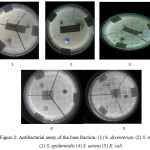 |
Figure 2: Antibacterial assay of the base fraction: (1) S. dysenteriae; (2) S. mutans (3) S. epidermidis (4) S. aereus (5) E. coli. |
Table 2: The inhibition zone (mm) of each tested bacteria.
|
Tested Materials |
Concentration (ppm) |
Inhibition zone (mm) |
||||
|
(1)* |
(2)* |
(3)* |
(4)* |
(5)* |
||
|
Methanol extract |
1000 |
15.7±1.0 |
17.3±0.6 |
18.3±0.6 |
19.3±0.3 |
13.7±0.5 |
|
100 |
12.3±0.5 |
13.0±0.0 |
14.0±1.0 |
17.4±0.6 |
12.0±1.0 |
|
|
10 |
11.0±0.0 |
12.0±1.0 |
10.7±0.5 |
14.7±0.5 |
10.0±1.0 |
|
|
Acid fraction |
1000 |
16.3±0.5 |
14.0±0.0 |
19.7±0.5 |
24.0±1.0 |
27.0±1.0 |
|
100 |
13.7±0.5 |
11.7±0.5 |
12.0±0.0 |
12.7±0.6 |
15.0±0.0 |
|
|
10 |
11.4±0.5 |
10.3±0.6 |
10.0±0.0 |
10.4±0.6 |
10.7±0.5 |
|
|
Base fraction |
1000 |
13.0±0.3 |
15.4±0.6 |
12.0±1.0 |
17.7±0.5 |
13.7±0.6 |
|
100 |
12.3±0.6 |
13.0±1.0 |
10.0±1.0 |
12.7±0.6 |
12.0±0.0 |
|
|
10 |
11.0±0.0 |
12.0±0.0 |
8.0±0.0 |
10.7±0.5 |
10.0±0.0 |
|
|
Positive control (Cyprofloxacin) |
0.5% |
50.0±1.0 |
50.0±1.7 |
35.0±1.0 |
35.0±1.0 |
35.0±1.0 |
|
Methanol |
PA grade ** |
0.0±0.0 |
0.0±0.0 |
0.0±0.0 |
0.0±0.0 |
0.0±0.0 |
|
DCM |
PA grade ** |
0.0±0.0 |
0.0±0.0 |
0.0±0.0 |
0.0±0.0 |
0.0±0.0 |
*(1) S. aereus, (2) E. coli, (3) S. dysenteriae, (4) S. mutans, (5) S. epidermidis ** Pro Analysis grade.
As shown in Table 2, similar to the bark bioactivity, all of leaves extracts possesses antibacterial properties. They were successfully hindering the bacterial growth from the concentration of 10 ppm. The raised of the extract concentration from 10 ppm to 1000 ppm in all experiments shown an increase of antibacterial activity. Generally, the widest inhibition zone in the leaves was showed in the acid fraction while the weakest was in the base fraction. The three extracts showed the strongest activity against S. mutans, gram-positive bacteria. For the acid fractions, it gave slightly resistance against E. coli (gram-negative bacteria), methanol extracts were against S. epidermidis (gram-positive bacteria) and the base fraction was against S. dysenteriae (gram-negative bacteria). Overall, the extracts had similar strength in inhibiting both type of bacteria (gram-negative and gram-positive bacteria). Nevertheless, their affectivities were lower than that of the bark especially the base fraction. This condition might be an indication for low alkaloid content in the leaves extracts as discussed below.
Future works have to be carried out to focus on investigating the chemical constituents responsible for antibacterial activities in the fractions of methanol and acidic fractions.
Alkaloidal Lombine Distribution Study
Alkaloid Distribution in the Plant
As it stated above, the alkaloid compound might be one of the responsible compounds for the antibacterial activity in the base fraction. Thus, to have an ensuring data about alkaloid presence in the plants, an alkaloid screening was conducted in the crude methanol extract of the plant from three different regions by using the semi-quantitative method of Mayer and Wagner reagent (Raaman, 2006). All the samples that added with Mayer reagent were showing white precipitation while the samples with Wagner reagent were changed into reddish-brown precipitation in various intensity marked + to +++ and results are listed in Table 3.
Table 3: The results of the alkaloid test using Mayer and Wagner reagents.
|
The plan Sample |
Alkaloid test | |
| Mayer | Wagner | |
| Bark from West Lombok |
+++ |
+++ |
| Leaves from West Lombok |
+ |
+ |
| Bark from north Lombok |
++ |
++ |
| Leaves from north Lombok |
+ |
+ |
| Bark from East Lombok |
+++ |
+++ |
| Leaves bark from East Lombok |
+ |
+ |
Table 3 indicates that alkaloids in the bark had a higher concentration than that of the leaves part. In other words, alkaloid compounds in the plant tended to accumulate in the bark rather than in the leaves. The methanol extract was then fractionated using acid-base extraction. Identification of the alkaloids was carried out by the use of GC-MS instrument in various temperature programs and the results are presented in Table 4. Temperature program influencing the separation mixture of the extract. A compound that has the same or lowers boiling point to the set program will go out of the column, then detected by the mass spectrometry (MS). A suitable temperature will separate the targeted alkaloid clearly from other components.
Table 4: The alkaloid compounds in the base fraction in the plant from three locations of Lombok island.
|
Identified Alkaloid |
The part of the plant |
Origin |
Temperature (oC) |
Percentage (%) |
|
Ibogamine |
Bark |
West Lombok |
260 |
9.77 |
|
Bark |
West Lombok |
270 |
48.19 |
|
|
Bark |
North Lombok |
270 |
9.70 |
|
|
Leave |
West Lombok |
280 |
6.47 |
|
|
Coronaridine |
Bark |
West Lombok |
260 |
5.51 |
|
Leaves |
East Lombok |
260 |
1.23 |
|
|
Lombine |
Bark |
West Lombok |
260 |
6.06 |
|
Bark |
East Lombok |
270 |
74.91 |
|
|
Bark |
North Lombok |
270 |
24.77 |
In the previous study by Hadi (2002), the alkaloids found in the V. foetida were voacristine (the roots), voacangine (the roots and the leaves), coronaridine (fruits) and lombine (barks). On the other hand, this research found a different type of indole alkaloid called ibogamine as a major compound in the barks and minor compound in the leaves. As for coronaridine, it was found in barks and the leaves as a minor compound.
Ibogamine (1) and coronaridine (2) are the common alkaloids found in plants of genus voacanga. They are classified as iboga alkaloid with characteristic fused indolo azepine isoquinuclidine ring system (Soriano-Garcia et al., 1988). As an iboga alkaloid, both of them have a similar therapeutic activity like antileishmanial activity, anti-addictive, and weak analgesic effect (Kupchan et al., (1963).
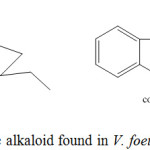 |
Figure 3: Indole alkaloid found in V. foetida. |
The compounds (1) and (2) were detected in the base fraction of the plant in the temperature of 260°C to 280°C. The alkaloid compounds were found with huge abundance in the temperature of 270°C. Hence, a temperature program of 270°C might be an optimum condition for indole alkaloids analysis in GCMS. By higher temperature setting (>280°C), detected compounds were more fatty acids and other unknown chemicals.
Ibogamine was found as a major alkaloid (48.19%) in the West Lombok’s plant, while it was found as a minor alkaloid in the plant from the two other areas. Coronaridine was majorly identified from the plant bark collected from West Lombok. Hence, West Lombok area was the main targeted source for collection of ibogamine and coronaridine from V. foetida (Bl.) Rolfe. Lombine was detected in the plant barks collected from the three locations and its highest concentration was found in the sample from East Lombok. The differences of secondary metabolites production including alkaloids depend on the plant species, a growth area, age and parts of the plants and situations stimulating their metabolite productions (Akula et al., 2011).
Lombine Identification Using GC-MS
Lombine is a new optical active alkaloid that was isolated by Hadi et al., (2002) from the barks of V. foetida that cultivated in Kekait Village, West Lombok, Indonesia. It was isolated using thin layer chromatography preparative (TLCP), detected as an indole alkaloid with m/z 352. It was identified using Low-resolution chemical ionization mass spectrometry (LRCIMS), High-resolution chemical ionization mass spectrometry (HRCIMS), Low-resolution electron impact mass spectrometry (LREIMS), IR spectrophotometry, and 2-D NMR.
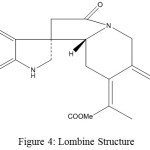 |
Figure 4: Lombine Structure. |
Gas Chromatography-Mass Spectrum (GC-MS) is a convenient instrument for secondary metabolites detection. It is sensitively detecting the compound by recognizing its mass fragmentation. A GC-MS database then will automatically display its compound information such as its structure and its molecular weight. However, lombine as a newly discover alkaloid has not added to the GC-MS database. Hence, its identification will merely depend on the previous MS fragmentation data of lombine from Hadi et al. (2002).
As an indole alkaloid, lombine gave a unique characteristic ion mass fragmentation of unsubstituted indoles moiety at m/z 130 and 144 (Figure 3). In addition, the presence of methyl and carbomethoxy group was indicated by the fragmentation of 337 and 293 m/z respectively. Furthermore, it gives a high peak at m/z 44 and 180. More importantly, there is a skeleton of the lombine fragment in m/z 172 or/and 208 (Figure 2) and m/z 352 as the signature of the lombine molecular weight.
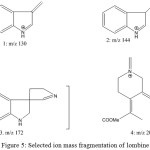 |
Figure 5: Selected ion mass fragmentation of lombine. |
Those fragmentation characteristics were found in the base fractions of the V. foetida barks from all sampling areas. On the other side, the leaves did not give any similarities to those MS fragmentations. Hence, it is deducted that lombine presents only in the barks. Further analysis is needed to find the lombine function and its biosynthesis pathways in the V. foetida, especially in the barks part. According to the GC-MS analysis, lombine was presented abundantly in the East Lombok’s sample (Table 4). Therefore, V. foetida that grows in this area is a preferable sample for further research of lombine isolation.
Lombine was detected in the temperature of 260°C-270°C. The temperature might be correlated to the lombine’s boiling point. A higher temperature was detecting some unidentified alkaloids that are targeted for separation, purification and bioactivity studies. Lombine will especially be promoted as drug lead for some therapeutic materials through derivatization and synthetic works.
Conclusion
Voacanga foetida (B.I) Rolfe is possessing antibacterial activities in both barks and the leaves. The highest antibacterial inhibition in the barks was possessed by the methanol extract while in the leaves, it was by the acid fraction. The base fractions containing alkaloids expected to give the highest antibacterial activities yet giving the lowest antibacterial activities in both of the bark and the leave parts, however, the presence of the alkaloids determining the activities. Further exploration indicated that the plant is positively containing alkaloids of ibogamine, coronaridine, and lombine found mostly in the bark. In addition, the plant sample collected from West Lombok region produce the highest amount of ibogamine and coronaridine, meanwhile, lombine was found abundantly in the sample from the area of East Lombok. Currently, the collection of the compounds has been done on the basis of the area in order to study their bioactivities especially lombine. Moreover, further research will be focused on investigating the chemical constituents responsible for antibacterial activities in the fractions of methanol and acidic fractions.
Acknowledgments
We would like to give a sincere grateful to MENRISTEK (Ministry of Research and Technology) of Indonesia for funding this research.
Conflict of Interest
There is no conflict of interest.
References
- Perry, L. M.; Judith, M. MIT press. 1980, 622.
- Riswan, S.; Dwi, A. Journal Farmasi Indonesia. 2008, 4 (2), 96-103.
- Hadi, S. Wollongong Thesis Collection. 2002.
- Novianti, D. S. University of Mataram Thesis Collection. 2014.
- Balouiri, M.; Sadiki, M.; Ibnsouda, S. K. Journal of pharmaceutical analysis. 2016. 6 (2), 71-79.
CrossRef - Raaman, N. New India Publishing agency. 2006, 19-24.
- Soriano-Garcia, M.; Rodriguez, A.; Walls, F.; Toscano, R. Journal of Crystallographic and Spectroscopic Research. 1989, 19 (4), 725-32.
CrossRef - Kupchan, S.; Morris, A.B.; Edward, M. Journal of pharmaceutical sciences. 1963, 52 (6), 598-599.
CrossRef - Akula, R.; Ravishankar, G.A. Plant signaling and behavior. 2011, 6 (11), 1720-31.
CrossRef

This work is licensed under a Creative Commons Attribution 4.0 International License.









